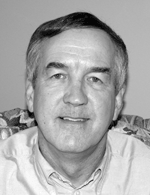Journey to a Career in Industry
Robert Starbuck Tells His Story
I became aware of the statistics field when I was an undergraduate student at Miami University in Oxford, Ohio. I signed up for a statistics course in which Donald Weber proctored one of the exams. He told me about a linear models course he would be teaching the next semester and showed me some of the course content. As a math major, I liked math a lot, but I had no idea how I might use a math degree to get a job in industry, which is where I wanted to spend my career. Statistics seemed ‘real world’ to me, so I signed up for Weber’s course and, based on that experience, took every other statistics course Miami offered.
Weber—who became a friend and mentor—advised me to apply for an NDEA fellowship and recommended I take a look at the statistics graduate program at North Carolina State University, where he earned his PhD. I took his advice and was fortunate to be awarded the fellowship and gain admittance to NC State.
Prior to going to NC State, I had only met two statisticians from industry—one at Procter & Gamble while I was at Miami and one at the Research Triangle Institute, with whom I arranged a chat when I visited NC State in the spring of my senior year at Miami. I mention this because these contacts were important in confirming my career path. (I would encourage statistics departments to increase the level of contact between their students and industrial and government statisticians, which would give students a better basis for deciding their career paths.)
I earned my master’s and PhD degrees in statistics at NC State. As I was finishing my master’s degree, I interviewed with a state agency. It was tempting to consider an employment opportunity because I was married with two young children, but I ultimately chose to stay in graduate school because I thought it would be difficult to earn a PhD while employed. I definitely made the right decision.
While at NC State, I taught an undergraduate introductory statistics course to nonstatistics majors. That experience gave me confidence in public speaking and a better idea of what it would be like to be a university instructor. I also heard an applied statistics talk by Mike Free, who worked at the Smith, Kline, & French pharmaceutical company. These two experiences further supported my career path decision.
I was fortunate to choose Charles Quesenberry as my thesis advisor. He had a good track record of getting PhD students through their theses and was always available to me and supportive of my efforts.
In preparation for the PhD written exams, several students and I worked through the questions on prior exams. The discussions we held were stimulating and thought-provoking and gave us different perspectives on the subject matter than we had obtained in the classroom. The knowledge gained was at least the equivalent of several graduate courses.
My first job was in Connecticut, where I worked for nearly two years in the environmental branch of Northeast Utilities Service Company, an electric power company that had nuclear power plants on the Connecticut River and Long Island Sound. I was the only statistician at NUSCO, and though the folks there were really fun to work with, I was uncomfortable being an isolated statistician and began looking for another job.
I had interviewed with the USDA at the same time I interviewed with NUSCO, so I contacted Bill Wigton, who worked at the USDA, had graduated from NC State several years before me, and was already a friend. Wigton had an opening that I took in his group in the Statistical Reporting Service, which was developing statistical methodology and computer software to use Landsat satellite data to enhance crop acreage estimation. The satellites took a reading every 18 days of each acre of ground, and each measurement had four dimensions—two in the visible and two in the infrared spectrum. A sample of acreage was photographed from the air, and USDA staff visited that acreage to confirm what was actually planted. That enumerated data was used to train discriminant analysis functions that were then applied to the satellite data to assign a specific land usage (e.g., water, trees, corn, soybeans) to each acre of land. While at the USDA, I also taught courses in introductory statistics and introductory nonparametric statistics.
I enjoyed working at the USDA, but wanted to own a house in which to raise my family. Due to the high cost of housing in the DC area, I could only have afforded a house a long distance from work, so I began exploring other employment venues.
At an ASA meeting in Chicago, I ran into Walt Cummings, who was looking to fill a position in his group at Burroughs Wellcome Company, a pharmaceutical firm in Research Triangle Park. I interviewed for the position and was offered the job, so moved to the Raleigh area. I worked at Burroughs Wellcome for nearly eight years, gaining experience in being a supervisor, designing clinical trials, and analyzing and reporting clinical trial data.
I then moved to Warner-Lambert/Parke-Davis in Ann Arbor, Michigan, where I became the head of their biometrics department and provided statistical support for preclinical and clinical trials. I went to Warner-Lambert/Parke-Davis to gain additional managerial responsibility and experience. The decision to move was difficult because I enjoyed working for Cummings and with my Burroughs Wellcome colleagues. Also, my family and I had many good friends in the Raleigh area. Realizing that my friends would continue to be my friends, however, I decided to move to Ann Arbor.


















